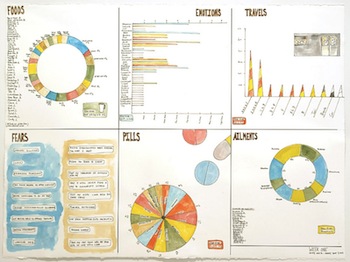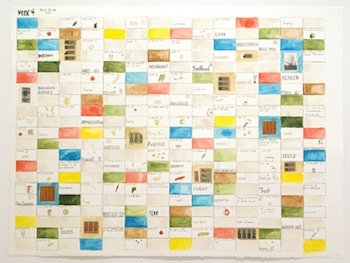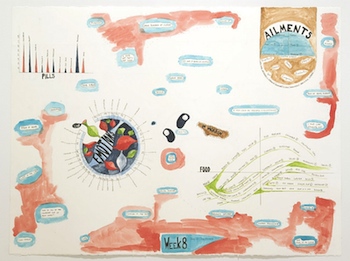
Christina Mazzalupo, "Countdown: Week 1," 2009. Ink and watercolor on paper, 22 1/2 x 30 in. Courtesy Mixed Greens.
Food diaries — daily records of everything one eats and drinks — are strange and fascinating objects. For nutritionists and dietitians, they are useful tools in determining a person’s eating habits and caloric intake. Taken out of a medical context, however, a blow-by-blow report of one’s ingestion seems trivial and neurotic. I’ll admit that I’ve kept my own food diary off and on over the years, repeatedly tucking it away once it became too tedious a task. When I stumbled upon one of my old journals a few years ago, I made a startling discovery: in logging teaspoons, cups, ounces and calories I had sketched a picture of my subconscious self. Bits and pieces of my life that were before unclear were laid out in my diet and notes. I was reminded of this epiphanic moment when I saw a new body of work by artist Christina Mazzalupo that takes her food diary as its starting point.
Since 2004, alternative healthcare practitioners have suggested Mazzalupo keep daily journals listing her food intake and bodily symptoms. For her exhibition Stomachache, now on view at Mixed Greens Gallery in New York, she has translated that documentation into eight drawings, one for every week leading up to her milestone 40th birthday.
If I was doubtful about the visual interestingness of this monotonous premise, I quickly forgot and was totally enthralled by Mazzalupo’s delicate ink and watercolor works on paper. Never has a food diary possessed the charm of a children’s coloring book and the density of a Mark Lombardi diagram. In addition to food and nutritional supplements, Mazzalupo has charted her medications, ailments, feelings, and journeys to reveal an extremely and sometimes uncomfortably personal memoir.

Christina Mazzalupo, "Countdown: Week 4," 2009. Ink and watercolor on paper, 22 1/2 x 30 in. Courtesy Mixed Greens.
Mazzalupo’s obsessively detailed lists and charts sometimes read like the tables of scientific journals. Countdown: Week 1 presents six distinct boxes titled “Foods,” “Emotions,” “Travels,” “Fears,” “Pills,” and “Ailments.” A number is written next to each item in a long register of mostly gluten-free foods. Diet Coke, salad, beef, brussels sprouts, and chocolate receive scores of one. The number two follows stuff like tofu, soy yogurt, and eggs on toast. Protein shakes, muffins, and tacos scale slightly higher. These foods and figures are then calculated into percentages and plotted on a multicolored donut chart. Decaf with soy made up the largest part of Mazzalupo’s diet that week at 15 percent. From a similar graphic, I learn that the artist is plagued by stomachaches, backaches, headaches, exhaustion, allergies, hives, dizziness, and swelling. Her list of her fears, written in black ink and bordered by clouds of brown and blue paint, ranges from loneliness and loss to repeated rejection from the MacDowell Colony and a bad art show. In another section, slabs of color stretch across a horizontal bar graph to reveal high levels of guilt, relief, and happiness, while feelings of love and anxiety are nil. This leads me to wonder about Mazzalupo’s medications; in a lovely pie chart of sky blue, mustard, and moss colors, Zoloft emerges as the dominant drug with a “high score” of 12 percent.
Here, as in her earlier works, Mazzalupo explores the relationship between creative process and the psychological. Food and other consumptions are a means of tapping into the latter. At one point, this set of drawings began to look like a sprawling legend or key to the bigger picture. Though my attempt to make concrete connections between colors and foods, foods and feelings, etc. was fruitless; just as I thought patterns were beginning to unfold, they seemed to tangle back up again. If one thing is clear, it’s that Mazzalupo’s stomachaches are chronic.

Christina Mazzalupo, "Countdown: Week 8," 2009. Ink and watercolor on paper, 22 1/2 x 30 in. Courtesy Mixed Greens.
Each of the eight drawings differs in style and tone and with each new week, the compositions appear less like charts and more like pictures. Countdown: Week 4 is a blocky grid of words, numbers, colors, and small renderings of fruits and vegetables. Countdown: Week 8, the final chart, exhibits a more fluid, emotive painting style. Rather than the enclosed sections of earlier weeks drawings, the details of Week 8 are depicted in island-like clumps. Standing back, the piece mildly resembles a satellite map. At this point, Mazzalupo’s eating is either less regimented or she has begun to tire of writing things down with such precision. In the end, her food intake appears to be shadowed by everything else.
Mazzalupo’s drawings show how food and consumption are connected to every instance of our lives. Taken as a whole, her works are almost too much to swallow, literally. Mazzalupo writes: “There is something to be said for giving recognition to the ingredients before you take a bite of the meal. It is so hard to truly comprehend the whole of things, the big picture, which is why I am an advocate of the tiny investigative bites.”
Stomachache is on view at Mixed Greens Gallery through March 13, 2010.




Pingback: What’s Cookin at the Art21 Blog: A Weekly Index | Art21 Blog
Pingback: Reader: March 10, 2010 « updownacross